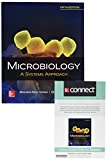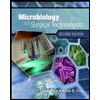
Concept explainers
Introduction:
Bacteria are prokaryotic organisms. There are four basic shapes of bacteria; rod-shaped, spherical, comma-shaped, and spiral. Bacteria are cosmopolitan in nature. There are some bacteria, which are pathogenic in nature. These bacteria cause diseases in plants and animals. Tuberculosis, cholera, pneumonia, and gonorrhea are some of the diseases that are caused by pathogenic bacteria.
Answer to Problem 1MCQ
Correct answer:
The most likely interpretation of isolation of two colonies of E. coli on a plate streaked from a urine sample is normal biota. Therefore, option (b) is correct.
Option (b) is given as “normal biota”.
Explanation of Solution
Justify reasons for the correct statement:
Normal biota refers to the microbes that are present within the humans. They are present in the deep layers of skin or on the surface of the skin, in the oral mucosa, in the saliva, GI (gastrointestinal) tract, and in the conjunctiva. If two colonies of E. coli (Escherichia coli) are isolated from a streaked plate of urine sample, then it is because this microbe is a member of the normal biota of the body and can be present in the sample.
Hence, option (b) is correct.
Justify reasons for the incorrect statements:
Option (a) is given as “probable infection”.
Presence of E. coli does not indicate a probable infection as this microbe is a part of normal biota of the body. Hence, it is a wrong answer.
Option (c) is given as “contamination”.
Presence of E. coli does not indicate contamination as this microbe is a part of the normal biota of the body. Hence, it is a wrong answer.
Hence, options (a) and (c) are incorrect.
E. coli is a member of the normal biota of the body and is not harmful. Its presence in a sample does not indicate contamination or probable infection.
Want to see more full solutions like this?
Chapter 17 Solutions
GEN COMBO LOOSELEAF MICROBIOLOGY:A SYSTEMS APPROACH; CONNECT ACCESS CARD
- Amino Acid Coclow TABle 3' Gly Phe Leu (G) (F) (L) 3- Val (V) Arg (R) Ser (S) Ala (A) Lys (K) CAG G Glu Asp (E) (D) Ser (S) CCCAGUCAGUCAGUCAG 0204 C U A G C Asn (N) G 4 A AGU C GU (5) AC C UGA A G5 C CUGACUGACUGACUGAC Thr (T) Met (M) lle £€ (1) U 4 G Tyr Σε (Y) U Cys (C) C A G Trp (W) 3' U C A Leu בוט His Pro (P) ££ (H) Gin (Q) Arg 흐름 (R) (L) Start Stop 8. Transcription and Translation Practice: (Video 10-1 and 10-2) A. Below is the sense strand of a DNA gene. Using the sense strand, create the antisense DNA strand and label the 5' and 3' ends. B. Use the antisense strand that you create in part A as a template to create the mRNA transcript of the gene and label the 5' and 3' ends. C. Translate the mRNA you produced in part B into the polypeptide sequence making sure to follow all the rules of translation. 5'-AGCATGACTAATAGTTGTTGAGCTGTC-3' (sense strand) 4arrow_forwardWhat is the structure and function of Eukaryotic cells, including their organelles? How are Eukaryotic cells different than Prokaryotic cells, in terms of evolution which form of the cell might have came first? How do Eukaryotic cells become malignant (cancerous)?arrow_forwardWhat are the roles of DNA and proteins inside of the cell? What are the building blocks or molecular components of the DNA and proteins? How are proteins produced within the cell? What connection is there between DNA, proteins, and the cell cycle? What is the relationship between DNA, proteins, and Cancer?arrow_forward
- please fill in the empty sports, thank you!arrow_forwardIn one paragraph show how atoms and they're structure are related to the structure of dna and proteins. Talk about what atoms are. what they're made of, why chemical bonding is important to DNA?arrow_forwardWhat are the structure and properties of atoms and chemical bonds (especially how they relate to DNA and proteins).arrow_forward
- The Sentinel Cell: Nature’s Answer to Cancer?arrow_forwardMolecular Biology Question You are working to characterize a novel protein in mice. Analysis shows that high levels of the primary transcript that codes for this protein are found in tissue from the brain, muscle, liver, and pancreas. However, an antibody that recognizes the C-terminal portion of the protein indicates that the protein is present in brain, muscle, and liver, but not in the pancreas. What is the most likely explanation for this result?arrow_forwardMolecular Biology Explain/discuss how “slow stop” and “quick/fast stop” mutants wereused to identify different protein involved in DNA replication in E. coli.arrow_forward
 Comprehensive Medical Assisting: Administrative a...NursingISBN:9781305964792Author:Wilburta Q. Lindh, Carol D. Tamparo, Barbara M. Dahl, Julie Morris, Cindy CorreaPublisher:Cengage Learning
Comprehensive Medical Assisting: Administrative a...NursingISBN:9781305964792Author:Wilburta Q. Lindh, Carol D. Tamparo, Barbara M. Dahl, Julie Morris, Cindy CorreaPublisher:Cengage Learning Microbiology for Surgical Technologists (MindTap ...BiologyISBN:9781111306663Author:Margaret Rodriguez, Paul PricePublisher:Cengage Learning
Microbiology for Surgical Technologists (MindTap ...BiologyISBN:9781111306663Author:Margaret Rodriguez, Paul PricePublisher:Cengage Learning





